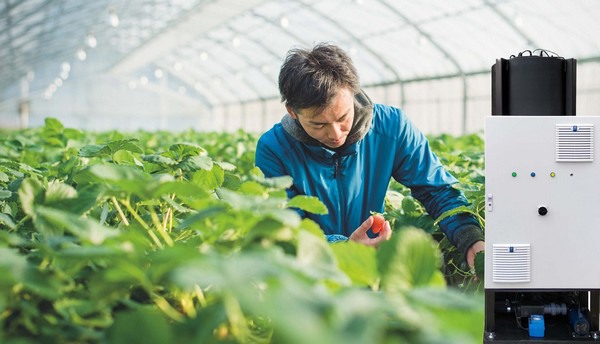The Dutch Assessment Committee for Purification Systems in Glasshouse Horticulture recently made a brief, factual announcement. That was just before the end of 2020. Hortibatch was approved and placed on growers' selection lists. At the time, strawberry grower Aart Cornelissen of APM Aardbeien already had the system up and running.
'Pure coincidence'
Aart is an end-user. As such, he helped the consortium develop the system. Manufacturer, Water Waves, is part of that group. Aart's 4,3-hectare farm now complies with the strictest legal water treatment requirements.
"Not many growers can or wants to purify in a cluster. Not all clusters met the 1 January deadline either. That's where this unique, compact system for wastewater purification and disinfection comes into its own," says Aart.
But, how did a strawberry grower become involved in the development of this system? "Pure coincidence, as it so often happens. We already knew each other from the neighborhood. About five years ago, Water Waves was looking for a grower to take part in the process. That was me. It helps that I also have a technical background."

Unique use of ultrasounds
The Hortibatch system is unusual. It combines three methods - UV-C radiation, hydrogen peroxide dosing, and ultrasound. The system uses ultrasound in a way that's unique in greenhouse cultivation. It uses ultrasound to clean the UV-C radiation lamps.
These lamps can be found in quartz protective tubes. "Many other systems use nitric acid or hydrochloric acid for this. We wanted to minimize the use of chemicals in the system as well. So, we opted not to use those," explains Cornelissen.
Ultrasound waves also help purify the water. "That's an additional positive effect. The system uses UV-C radiation and hydrogen peroxide to oxidize pesticides found in the water. The ultrasonic vibrations strengthen this process."
A single pallet
The compact system fits on a single 120x80cm Euro pallet. For Aart, one unit is sufficient. He grows strawberries on racks and in greenhouses. "Growers are increasingly minimizing their residual flows. So, it's not so much the greenhouse size that's important when choosing a system. But rather the flow of processed water a grower wants to discharge."
The Hortibatch comes in various models. Their capacity ranges from 0.33 to 2.01 cubic meters/hour. That depends on the filling and emptying pump. The water is treated in batches and ultrasound is used in frequency sweeps. The system is, therefore, energy-efficient. "The footprint of the entire installation is limited to a single Euro pallet," says Aart.
Maintenance-friendly
No pre-filtration is needed, so the system is maintenance-friendly too. That's important when Aart goes back into production in mid-February. He can then start working towards his first harvest in mid-April. "The purification system is fully automated."
"It has a digital logbook and alarms. It also has a dashboard. You can open this on your computer or smartphone via a local network. I happily show the system to those fellow farmers that show interest. You could call me a kind of demo nursery for it," concludes Aart.
For more information:
APM Aardbeien V.O.F.
Facebook page
Email: info@apmberlikum.nl
Water Waves
Website: www.waterwaves.nl
Website: www.hortibatch.nl
